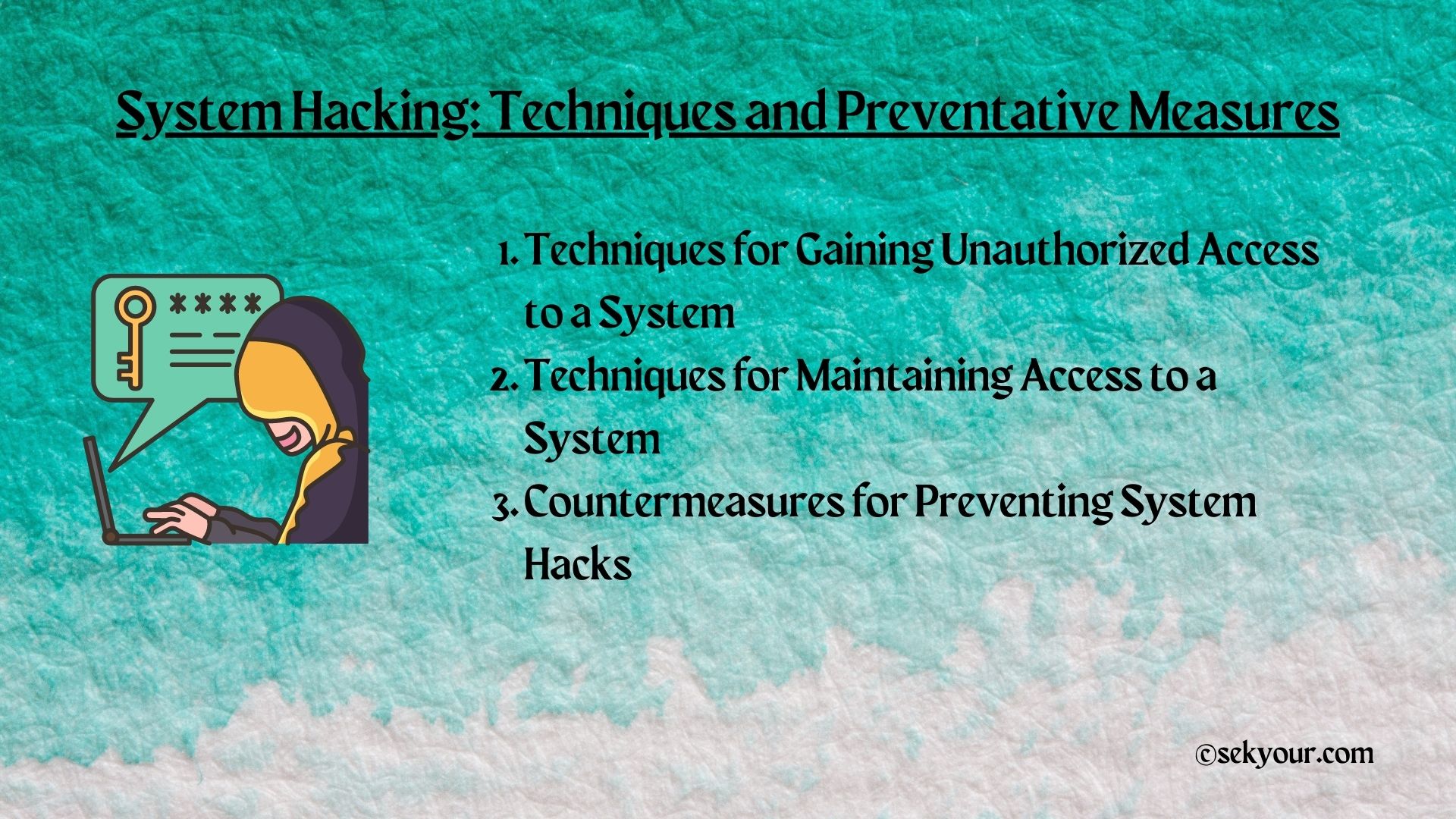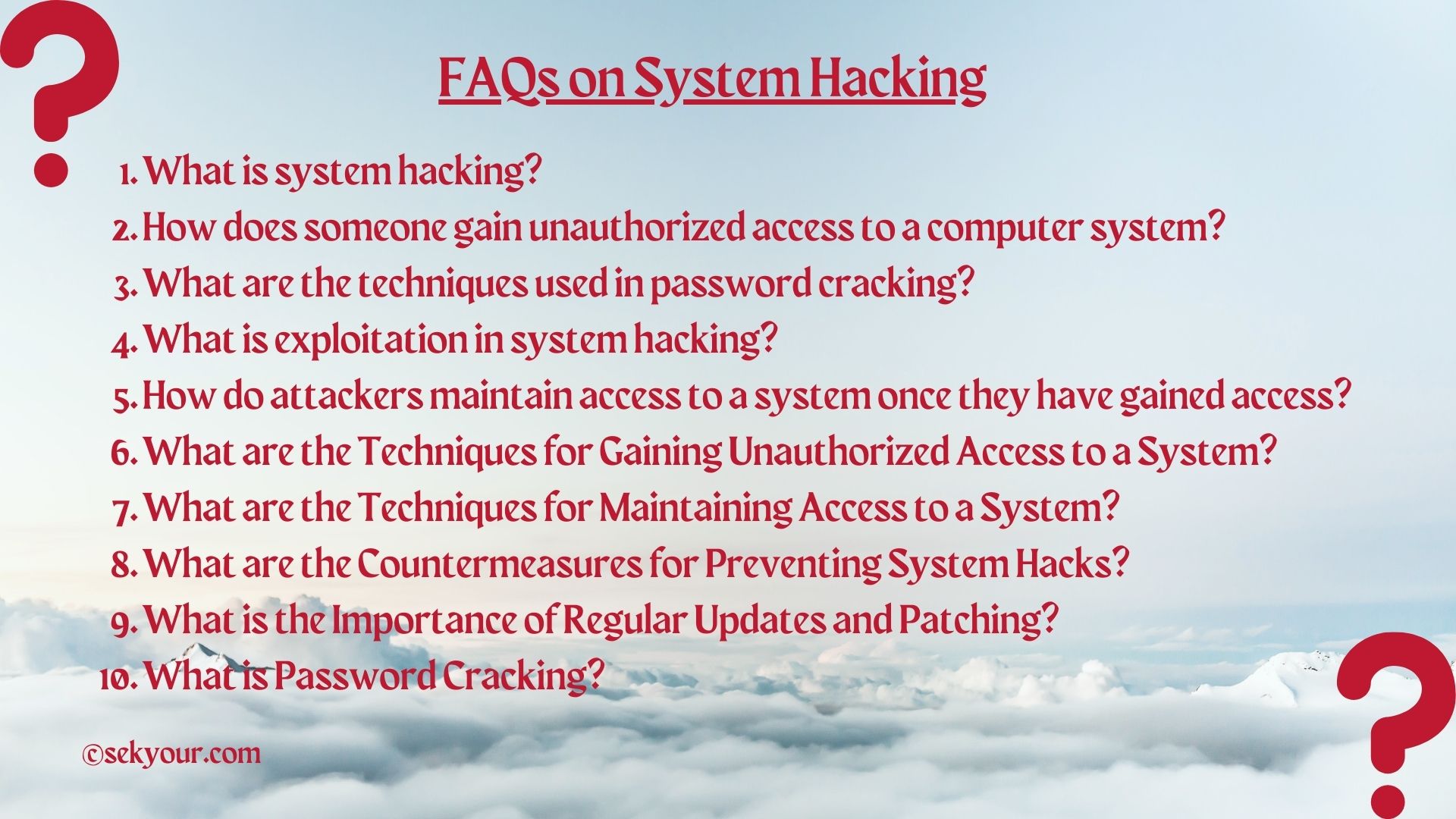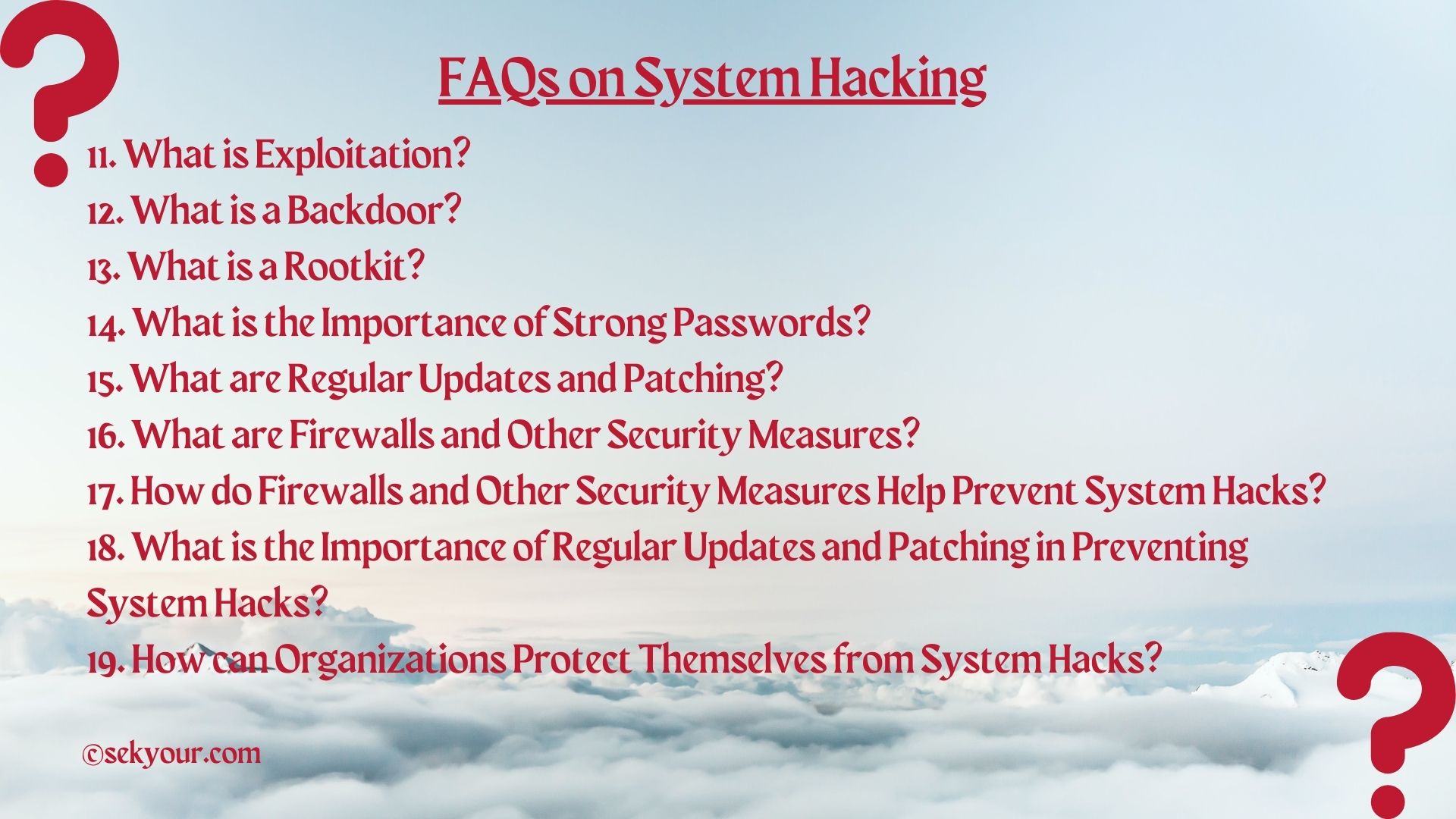1. Introduction
1.1 Definition of System Hacking
System hacking refers to gaining unauthorized access to a computer system and its resources. This can be done through various methods, including exploiting vulnerabilities in the system, cracking passwords, or using backdoors to maintain access. System hacking is a significant threat to the security and privacy of individuals and organizations. Understanding the techniques hackers use to prevent and defend against such attacks is essential.
1.2 Importance of Understanding System Hacking
Understanding system hacking is crucial in today’s digital age, as the amount of sensitive information stored on computers continues to grow. System hacks can result in the theft of sensitive information, damage to systems and data, and the compromise of personal and financial information. By understanding the methods hackers use, individuals and organizations can take steps to prevent and defend against such attacks, thus protecting their sensitive data and assets. Additionally, understanding system hacking can help organizations improve their overall security posture by identifying and addressing potential vulnerabilities in their systems.

2. Techniques for Gaining Unauthorized Access to a System
2.1 Password Cracking
2.1.1 Overview of Password Cracking
Password cracking is a common technique hackers use to gain unauthorized access to a system. It involves guessing or generating passwords for a target system to gain access. This can be done through specialized tools that automate the process of password guessing. These tools can generate a large number of potential passwords in a short amount of time, making it easier for hackers to gain access to a target system.
2.1.2 Tools used in Password Cracking
Various tools can be used for password cracking, ranging from simple command-line utilities to sophisticated graphical user interfaces. Some popular tools used in password cracking include John the Ripper, Cain and Abel, and Hashcat. These tools can be used to perform dictionary attacks, brute-force attacks, and other methods of password cracking. In addition to these specialized tools, hackers may also use other tools, such as network analyzers and sniffers, to gather the information that can be used in a password-cracking attempt.
2.2 Exploitation
2.2.1 Overview of Exploitation
Exploitation is another technique hackers use to gain unauthorized access to a system. It involves taking advantage of a vulnerability in the system to gain access. These vulnerabilities can exist in the system software, such as an operating system or application, or in the system’s configuration. Exploitation can be performed remotely, meaning the attacker does not need physical access to the target system, or locally, meaning the attacker has direct access to the system.
2.2.2 Types of Vulnerabilities that can be Exploited
There are many types of vulnerabilities that can be exploited by hackers, including software vulnerabilities, network vulnerabilities, and configuration vulnerabilities. Some common software vulnerabilities include buffer overflows, SQL injection, and cross-site scripting. Network vulnerabilities include unsecured Wi-Fi networks, unpatched routers, and open ports. Configuration vulnerabilities include unsecured default accounts, unpatched software, and weak passwords. Understanding these vulnerabilities and taking steps to address them is key to preventing exploitation and unauthorized access to systems.
3. Techniques for Maintaining Access to a System
3.1 Backdoors
3.1.1 Overview of Backdoors
Backdoors are hidden methods of accessing a system that is used by hackers to maintain access after initially gaining unauthorized access. These backdoors are often created due to exploiting a vulnerability in the system. They allow the attacker to continue to access the system even after security measures have been put in place to prevent access. Backdoors can also be installed by hackers to maintain control over a system, even if the original vulnerability has been patched.
3.1.2 Types of Backdoors
There are several types of backdoors that hackers can use, including software backdoors, hardware backdoors, and firmware backdoors. Software backdoors are typically installed as malicious code in software applications or operating systems, while hardware backdoors can be built into the physical hardware of a system. Firmware backdoors are similar to hardware backdoors, but they are built into the firmware that controls the operation of a system. All types of backdoors can be difficult to detect and remove, making it important for organizations to implement security measures to prevent their creation and use.
3.2 Rootkits
3.2.1 Overview of Rootkits
Rootkits are malicious software programs that can be installed on a system to maintain control and persistently hide the presence of the attacker. Rootkits can be used to hide files, processes, network connections, and other elements that might give away the presence of an attacker on a system. They are often installed after a system has been compromised through other means, such as exploiting a vulnerability or stealing login credentials.
3.2.2 Examples of Rootkits
There are several types of rootkits that attackers, including user-mode rootkits, kernel-mode rootkits, and bootkit rootkits can use. User-mode rootkits operate at the user level of a system and can hide the presence of malicious software. In contrast, kernel-mode rootkits operate at the kernel level of an operating system and can hide the presence of malware and malicious processes. Bootkit rootkits are a type of rootkit that can infect the boot process of a system and can persist even after a system is reinstalled or reimaged. These rootkits can be difficult to detect and remove, making it important for organizations to implement strong security measures to prevent their use.
4. Countermeasures for Preventing System Hacks
4.1 Strong Passwords
4.1.1 Importance of Strong Passwords
The use of strong passwords is one of the most critical steps that can be taken to prevent system hacks. Weak or easily guessable passwords are one of the most common methods that attackers use to gain unauthorized access to systems. Using strong passwords can significantly reduce the risk of successful attacks.
4.1.2 Tips for Creating Strong Passwords
When creating a strong password, it is essential to use a combination of letters, numbers, and special characters and to avoid using easily guessable information, such as a person’s name, birthdate, or common words. It is also recommended to use long passwords at least 12 characters and avoid using the same password for multiple accounts. To help remember complex passwords, using a password manager or creating a mnemonic device can be helpful. By following these guidelines and regularly updating passwords, organizations can significantly reduce the risk of successful attacks and protect sensitive information and systems.
4.2 Regular Updates and Patching
4.2.1 Overview of Updates and Patching
Updates and patching refer to installing updates and patches to software and systems to fix vulnerabilities and improve security. This can include updating operating systems, software applications, and firmware on routers and firewalls.
4.2.2 Importance of Regular Updates and Patching
Regular updates and patching are important for preventing system hacks because they help to close vulnerabilities in systems that attackers can exploit. By regularly installing updates and patches, organizations can reduce the risk of successful attacks and ensure their systems are secure and protected.
4.3 Firewalls and Other Security Measures
4.3.1 Overview of Firewalls and Other Security Measures
Firewalls and other security measures are tools and technologies that prevent unauthorized access to systems and networks. This can include firewalls, intrusion detection and prevention strategies, virtual private networks (VPNs), and other security technologies.
4.3.2 Importance of Firewalls and Other Security Measures in Preventing System Hacks
Firewalls and other security measures are essential for preventing system hacks because they help to block access to unauthorized users and prevent malicious traffic from reaching a system. By implementing firewalls and other security measures, organizations can better protect their systems and reduce the risk of successful attacks. Additionally, by regularly monitoring and updating these security measures, organizations can ensure that their systems are protected and up-to-date.
5. Conclusion
5.1 Summary of Key Points
In this article, we explored the definition and techniques of system hacking, the ways to maintain access to a system, and the countermeasures for preventing system hacks. We defined system hacking as the process of gaining unauthorized access to a computer system and its resources, and discussed techniques such as password cracking and exploitation that can be used to gain access. We also discussed backdoors and rootkits, which can be used to maintain access to a system, and countermeasures such as strong passwords, regular updates and patching, and firewalls and other security measures, which can be used to prevent system hacks.
5.2 Final Thoughts on System Hacking and Prevention
Individuals and organizations must understand the threat of system hacking and take steps to prevent it. By implementing strong passwords, regularly updating and patching systems, and using firewalls and other security measures, organizations can better protect themselves from successful attacks. Additionally, it is essential to stay informed about the latest threats and trends in system hacking and continuously improve security measures. The risks associated with system hacking are constantly evolving, so it is essential to be proactive in protecting systems and resources from unauthorized access.
6. FAQs on System Hacking

1. What is system hacking?
System hacking refers to gaining unauthorized access to a computer system and its resources. It is breaking into a computer system to exploit vulnerabilities and access sensitive information, data, or resources. This type of hacking is often done with malicious intent and can cause harm to individuals, organizations, and businesses.
2. How does someone gain unauthorized access to a computer system?
Someone can gain unauthorized access to a computer system through various techniques such as password cracking, exploiting vulnerabilities, and taking advantage of security weaknesses. Password cracking involves using specialized tools to guess or generate passwords for a target, while exploitation involves taking advantage of a vulnerability in a system to gain access.
3. What are the techniques used in password cracking?
Password cracking involves using specialized tools to guess or generate passwords for a target. This can be done through brute force methods, dictionary attacks, or pre-computed tables of hashes to find the correct password. Other techniques used in password cracking include exploiting weak passwords, exploiting vulnerabilities in the authentication process, and using social engineering tactics to trick individuals into revealing their passwords.
4. What is exploitation in system hacking?
Exploitation in system hacking refers to taking advantage of a vulnerability in a system to gain unauthorized access. This can be done by finding and exploiting a weakness in the design, such as a flaw in the software, hardware, or network security, to gain access and control over the target system. Exploitation can also be used to spread malware or steal sensitive information.
5. How do attackers maintain access to a system once they have gained access?
Once access has been gained, attackers need to maintain that access to continue to gather information and potentially cause further damage. This can be done using backdoors, which are hidden methods of accessing a system, or rootkits, malicious software that can be installed on a system to maintain control. Backdoors and rootkits allow attackers to persist within the system and continue their malicious activities even after gaining initial access.
6. What is System Hacking?
System Hacking is the process of unauthorized access to a computer system and its resources. It involves exploiting vulnerabilities in a system to gain access to sensitive information or to cause damage.
7. What are the Techniques for Gaining Unauthorized Access to a System?
Several techniques for gaining unauthorized access to a system include password cracking and exploitation. Password cracking involves using specialized tools to guess or generate passwords for a target, while exploitation involves taking advantage of a vulnerability in a system to gain access.
8. What are the Techniques for Maintaining Access to a System?
Once access has been gained, it is essential to maintain that access to continue to gather information and potentially cause further damage. This can be done through the use of backdoors, which are hidden methods of accessing a system, or rootkits, which are malicious software that can be installed on a system in order to maintain control.
9. What are the Countermeasures for Preventing System Hacks?
Some countermeasures that can be taken to prevent system hacks include implementing strong passwords, regularly updating and patching systems, and using firewalls and other security measures to block access to unauthorized users.
10. What is the Importance of Regular Updates and Patching?
Regular updates and patching are important for maintaining the security of a computer system. This is because updates and patches often address vulnerabilities discovered and exploited by hackers. By regularly updating and patching systems, organizations can avoid potential threats and reduce the risk of system hacks.

11. What is Password Cracking?
Password cracking is a technique used in system hacking to gain unauthorized access to a system. It involves using specialized tools to guess or generate passwords for a target. This can be done through brute force attacks, dictionary attacks, and social engineering tactics.
12. What is Exploitation?
Exploitation is a technique used in system hacking to gain unauthorized access to a system by taking advantage of a vulnerability. This can involve exploiting weaknesses in software, operating systems, or other parts of a system in order to gain control and access sensitive information.
13. What is a Backdoor?
A backdoor is a hidden method of accessing a system that can be used to maintain control after gaining unauthorized access. Backdoors can be installed on a system by a hacker or through malicious software. This allows attackers to maintain access even if their original entry point is discovered and blocked.
14. What is a Rootkit?
A rootkit is malicious software that can be installed on a system to maintain control after gaining unauthorized access. Rootkits can hide themselves and other malicious software from detection by security software, making them difficult to remove and leaving systems vulnerable to further attacks.
15. What is the Importance of Strong Passwords?
Strong passwords are an important factor in preventing system hacks. They can make it more difficult for hackers to guess or crack passwords, thus reducing the risk of unauthorized access to a system. Strong passwords typically include uppercase and lowercase letters, numbers, and symbols and are at least eight characters long.
16. What are Regular Updates and Patching?
Regular updates and patching refer to keeping software and systems up-to-date with the latest security patches and updates. This is important in preventing system hacks because it helps close any vulnerabilities in older software or systems, making them less susceptible to attack.
17. What are Firewalls and Other Security Measures?
Firewalls and other security measures are technologies designed to block unauthorized access to a system. Firewalls can restrict access to a system based on specific criteria, such as IP address or type of connection. At the same time, other security measures can include antivirus software, intrusion detection systems, and access control systems.
18. How do Firewalls and Other Security Measures Help Prevent System Hacks?
Firewalls and other security measures help prevent system hacks by providing a protection barrier between systems and potential attackers. By restricting access and monitoring for suspicious activity, these technologies can help to prevent unauthorized access and mitigate the risk of successful system hacks.
19. What is the Importance of Regular Updates and Patching in Preventing System Hacks?
Regular updates and patching are essential in preventing system hacks because they help close any vulnerabilities in older software or systems. Hackers often target older, unpatched systems as these are easier to exploit and can provide a more attractive target. Organizations can reduce their risk of falling victim to a system hack by regularly updating and patching systems.
20. How can Organizations Protect Themselves from System Hacks?
Organizations can protect themselves from system hacks by implementing a combination of countermeasures, including strong passwords, regular updates and patching, firewalls, and other security measures. Organizations can also educate employees on safe computing practices, such as avoiding suspicious emails and links, to reduce the risk of successful attacks.